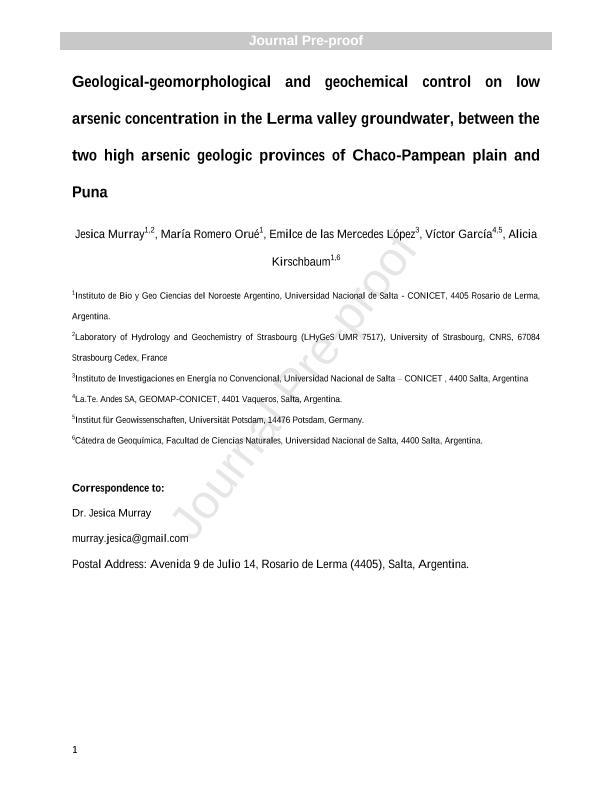Mostrar el registro sencillo del ítem
dc.contributor.author
Murray, Jesica María

dc.contributor.author
Romero Orué, María Angélica

dc.contributor.author
López, Emilce de Las Mercedes

dc.contributor.author
García, Víctor
dc.contributor.author
Kirschbaum, Alicia Matilde

dc.date.available
2021-01-21T21:31:22Z
dc.date.issued
2019-09
dc.identifier.citation
Murray, Jesica María; Romero Orué, María Angélica; López, Emilce de Las Mercedes; García, Víctor; Kirschbaum, Alicia Matilde; Geological-geomorphological and geochemical control on low arsenic concentration in the Lerma valley groundwater between the two high arsenic geologic provinces of Chaco-Pampean plain and Puna; Science of the Total Environment; Science of the Total Environment; 699; 9-2019; 1-44
dc.identifier.issn
0048-9697
dc.identifier.uri
http://hdl.handle.net/11336/123383
dc.description.abstract
Argentina is known for having one of the most extensive areas with high arsenic (As) concentration in groundwater in the world. These areas correspond to two main geological provinces, the Puna plateau and the Chaco-Pampean plain. In this large territory, there are some specific environments where the As concentration in groundwater is lower, and in some cases within the recommended limits for drinking water. In our study, we analyze and interpret the low arsenic concentrations reported for the Lerma valley, the easternmost intermontane basin of the Cordillera Oriental, located between the aforementioned high-arsenic geological provinces. The groundwater from this valley is used for the consumption of more than 600.000 inhabitants in the city of Salta and nearby towns. The incipient development of the valley since the late Miocene and the subsequent tectonic and climatic evolution favored low As concentrations with respect to the Puna and the Chaco-Pampean plain. The high-energy sedimentary environments thatcharacterized the area during Plio-Quaternary times and the composition of the sediments have controlled the characteristics of sediments the multilayered aquifer. Moreover, the absence of geogenic arsenic sources, climate, high rain infiltration rate, near neutralpH,redox conditions, and wells construction with screens settledincoarse productive layers favor groundwater of good quality.The geological and tectonic evolution of the Lerma valley could be extrapolated to other similar valleys in the NW of Argentinaand can be useful as tool for exploration of good quality groundwater. This is of high importance in Latin American territories with high As concentration in groundwater such as Argentina.
dc.format
application/pdf
dc.language.iso
eng
dc.publisher
Science of the Total Environment
dc.rights
info:eu-repo/semantics/openAccess
dc.rights.uri
https://creativecommons.org/licenses/by-nc-sa/2.5/ar/
dc.subject
CORDILLERA ORIENTAL
dc.subject
GROUNDWATER GEOCHEMISTRY
dc.subject
LOW ARSENIC IN GROUNDWATER
dc.subject
NORTHWEST ARGENTINA
dc.subject
TECTONIC AND SEDIMENTARY EVOLUTION
dc.subject.classification
Geoquímica y Geofísica

dc.subject.classification
Ciencias de la Tierra y relacionadas con el Medio Ambiente

dc.subject.classification
CIENCIAS NATURALES Y EXACTAS

dc.title
Geological-geomorphological and geochemical control on low arsenic concentration in the Lerma valley groundwater between the two high arsenic geologic provinces of Chaco-Pampean plain and Puna
dc.type
info:eu-repo/semantics/article
dc.type
info:ar-repo/semantics/artículo
dc.type
info:eu-repo/semantics/publishedVersion
dc.date.updated
2020-11-18T20:46:30Z
dc.journal.volume
699
dc.journal.pagination
1-44
dc.journal.pais
Estados Unidos

dc.description.fil
Fil: Murray, Jesica María. Consejo Nacional de Investigaciones Científicas y Técnicas. Centro Científico Tecnológico Conicet - Salta. Instituto de Bio y Geociencias del NOA. Universidad Nacional de Salta. Facultad de Ciencias Naturales. Museo de Ciencias Naturales. Instituto de Bio y Geociencias del NOA; Argentina. University of Strasbourg; Francia
dc.description.fil
Fil: Romero Orué, María Angélica. Consejo Nacional de Investigaciones Científicas y Técnicas. Centro Científico Tecnológico Conicet - Salta. Instituto de Bio y Geociencias del NOA. Universidad Nacional de Salta. Facultad de Ciencias Naturales. Museo de Ciencias Naturales. Instituto de Bio y Geociencias del NOA; Argentina
dc.description.fil
Fil: López, Emilce de Las Mercedes. Consejo Nacional de Investigaciones Científicas y Técnicas. Centro Científico Tecnológico Conicet - Salta. Instituto de Investigaciones en Energía no Convencional. Universidad Nacional de Salta. Facultad de Ciencias Exactas. Departamento de Física. Instituto de Investigaciones en Energía no Convencional; Argentina
dc.description.fil
Fil: García, Víctor. Geomap S.a.; Argentina. Consejo Nacional de Investigaciones Científicas y Técnicas; Argentina. Universitat Potsdam; Alemania
dc.description.fil
Fil: Kirschbaum, Alicia Matilde. Consejo Nacional de Investigaciones Científicas y Técnicas. Centro Científico Tecnológico Conicet - Salta. Instituto de Bio y Geociencias del NOA. Universidad Nacional de Salta. Facultad de Ciencias Naturales. Museo de Ciencias Naturales. Instituto de Bio y Geociencias del NOA; Argentina
dc.journal.title
Science of the Total Environment

dc.relation.alternativeid
info:eu-repo/semantics/altIdentifier/url/https://linkinghub.elsevier.com/retrieve/pii/S0048969719342366
dc.relation.alternativeid
info:eu-repo/semantics/altIdentifier/doi/http://dx.doi.org/10.1016/j.scitotenv.2019.134253
Archivos asociados
